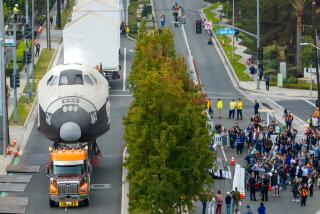NASA gives California Science Center museum last remaining space shuttle fuel tank

How the space shuttle’s external tank will travel from New Orleans to Los Angeles where it will be placed on display at the California Science Center.
- Share via
The California Science Center is the only museum in the nation that planned to make its space shuttle exhibit with as many authentic parts as possible, set up as if it’s ready to launch.
There was a problem. The enormous orange external fuel tank, which attaches to the shuttle’s belly, is always burned up in the atmosphere shortly after liftoff. Museum officials figured they’d have to settle for a replica.
But in a coup for the Science Center, NASA has agreed to give the last remaining external fuel tank to the state-run museum’s Endeavour exhibit, officials are announcing Thursday. The move is set for late this year, and would happen in November at the earliest.
The fuel tank is huge. At 153.8 feet in length, it is taller than a 15-story building and longer than Endeavour’s 122 feet. But it is skinnier, with a diameter of 27.6 feet, because it has no wings, which will make it generally easier than the shuttle for movers to navigate the streets of Los Angeles.
At about 66,000 pounds, it is less than half the weight of Endeavour.
The fuel tank will come to California the same way it was shipped to Kennedy Space Center in Florida — by barge. It will start a journey of 30 to 45 days at sea from NASA’s Michoud Assembly Facility in New Orleans, where the fuel tanks were built by Lockheed Martin, and pass through the Panama Canal, ending up in Marina del Rey.
Then it will begin a daylong journey through the streets of Southern California to get to the Science Center near downtown Los Angeles.
“We are very excited,” said Jeffrey N. Rudolph, president of the Science Center. “A lot of people at NASA see the value in having one place in the world where there could be the full space shuttle showing the full system in one place.”
At a time when there are a lot of fake, Hollywood-style replicas, nothing beats the real thing, Rudolph said.
“It’s the reason why so many people have been coming to see the shuttle. There’s a value in authenticity,” he said. “In today’s world, you can see anything virtually. Seeing the real thing is not so common anymore.”
The journey could be similar to the spectacle Los Angeles experienced in 2012, when thousands gathered along the city’s wide boulevards to cheer Endeavour’s arrival.
It will be a slow trip, but the fuel tank’s relatively svelte shape will make things easier. Officials don’t believe they’ll have to take down high-voltage power lines, as had to be done to accommodate Endeavour’s tall tail. Turns will still be a challenge, but officials say no trees will have to be uprooted. Traffic lights will have to be temporarily removed, but that’s easier to do because they can be unbolted.
The external tank was one of three main sources of fuel for Endeavour when it lifted off. The two others were the twin solid rocket boosters, which helped lift the shuttle in the first two minutes of flight. Because the rocket boosters were reusable, they were easy to obtain, said Dennis R. Jenkins, the project director overseeing the museum’s Samuel Oschin Air and Space Center and a former contract engineer who worked on the shuttle program.
But there was just one external fuel tank remaining, called ET 94, built at a cost of $75 million. It was considered a lightweight tank, intended to pull the shuttle into low-earth orbit. This version was cheaper to build than the super lightweight tanks, which were able to carry more cargo to the International Space Station.
After the shuttle Columbia burned up on reentry in 2003, killing the astronauts on board, NASA reprioritized its missions to complete the space station before retiring the shuttle fleet. “We never flew another low-earth science mission,” Jenkins said. “So this one tank sat there, waiting for a mission, and we never flew another mission that was appropriate for it.”
After the shuttle program ended in 2011, there were initial signs that NASA needed the tank for its work on building the replacement to the space shuttle, which would take astronauts much farther from Earth’s orbit, such as to an asteroid or Mars. In the end, the design of the replacement vehicle changed so dramatically that NASA didn’t need the fuel tank anymore.
“Then it just sat there. NASA was going to put it on display at the factory that built it, but we made a better plea,” Jenkins said. “NASA thought it was a better use of the resource and gave it to us.”
The external fuel tank is a feat of engineering. The tank contained both fuel — liquid hydrogen — and liquid oxygen to make the shuttle’s engines burn. The tank carried a maximum of 1.6 million pounds of propellants. The aluminum tank flexed and vibrated while being pushed by aerodynamic forces of thousands of miles per hour.
The tank has also been a source of safety problems. It is surrounded by hard foam intended to prevent ice from forming on the outside skin, and it insulates the liquid hydrogen and liquid oxygen inside. During launch, the foam skin is several hundred degrees on the outside and several hundred degrees below zero on the inside.
But that foam routinely fell off during shuttle launches. During its last launch, foam debris damaged Columbia’s sensitive heat shield, allowing superheated gases to break into the wing when it returned to Earth’s atmosphere.
Once the external tank arrives at the Science Center, it will be stored horizontally in a temporary fabric building just north of the temporary home of Endeavour. The museum is hoping to have a transparent section of fabric that will allow visitors to peer at the tank from the outside.
Los Angeles Mayor Eric Garcetti called the arrival of the fuel tank “a giant win for L.A.” and a big boost for what is already a significant tourist destination.
“It’ll be a pretty exciting day for L.A. to watch that come through our city,” Garcetti said.
[email protected]
[email protected]
Follow us on Twitter for more graphics and explainers on California news: @ronlin, @ranoa
More to Read
Sign up for Essential California
The most important California stories and recommendations in your inbox every morning.
You may occasionally receive promotional content from the Los Angeles Times.











